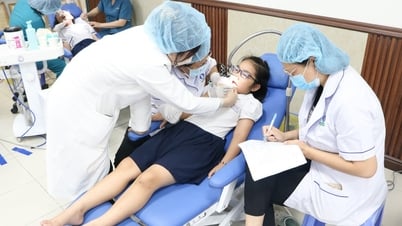In particular, after the period of social distancing due to the Covid-19 pandemic, when children had to study online at home, had little exercise and an uncontrolled diet, obesity became more and more common.
 |
| A proper diet and appropriate exercise will help children avoid the risk of obesity. |
A recent case at Medlatec Thanh Xuan General Clinic has attracted special attention, when a 15-year-old boy weighing more than 110 kg was found, a strong warning to parents about the need to pay attention and make timely adjustments to their children's health and nutrition.
Little NGH, 15 years old, living in Hanoi, is one of the notable cases. Although very young, her weight has reached 110 kg.
In the past 3 months, baby H. has gained more than 20 kg quickly and uncontrollably. Worried about this condition, the family took the baby to Medlatec Thanh Xuan General Clinic for examination.
Here, doctors recorded H.'s height as 176 cm, with a BMI of up to 35.5 kg/m², which is considered severely obese. According to the family, the child's weight gain has lasted for the past 4 years, and has increased rapidly after the period of social distancing due to the pandemic.
During that time, the child mainly studied and lived at home, had little exercise, ate a lot of processed foods, fast food and drank carbonated soft drinks. At each meal, the child ate 3 bowls of rice, drank 1 can of soft drink and ate 2 large bags of chips.
Test results showed that baby H. had high blood sugar and uric acid levels, and was also deficient in vitamin D - factors that cannot be ignored, because they are directly related to an unhealthy diet and lifestyle.
Doctors diagnosed the child with obesity, pre-diabetes and vitamin D deficiency. This is a worrying consequence of lack of control in the child's diet.
Obesity is not only an aesthetic problem but also a dangerous disease, negatively affecting both the physical and mental health of children.
According to MSc. Dr. Tran Thi Kim Ngoc, Pediatrics specialist, Medlatec Thanh Xuan General Clinic, there are many causes leading to obesity in children, the most common of which is an unreasonable diet: Children eat too much food rich in fat, sugar, and lack of fiber.
Fast food, fried foods, carbonated soft drinks, sweet cakes and candies... cause the amount of calories consumed to exceed the amount of energy the body can expend, leading to excess fat accumulation.
Genetic factors: Children are at high risk of obesity if someone in their family has this disease. Genetics contribute to determining the percentage of fat in the child's body.
Psychosocial effects: Children under academic pressure, stress or psychological trauma are more likely to turn to food, especially sweets, as a way to soothe their emotions.
Unscientific living habits: Habits of sitting for long periods, watching TV, playing games, being lazy, and not getting enough sleep are also factors that increase the risk of being overweight and obese.
What is worrying is that many parents are not aware of the seriousness of obesity in their children, or only care when there are obvious signs such as leg pain, back pain or concerns about height. The notion that "children must be chubby to be healthy" is still common in many families, leading to subjectivity and ignoring potential risks.
Childhood obesity not only affects physical development, but also leads to serious health consequences in the future.
Obese children are at high risk of developing chronic diseases such as diabetes, cardiovascular disease, high blood pressure, and even cancer as adults. Obesity also causes many psychological problems, such as low self-esteem, loss of confidence, depression, and stress. Children are easily discriminated against and isolated by their friends, which affects their ability to communicate and learn.
The scary thing is that these effects do not show up immediately, causing many parents to be complacent, only seeking help when the situation becomes serious. Therefore, timely detection and intervention of childhood obesity is an important factor in protecting the health and future of children.
When detecting obesity in children, timely intervention is extremely necessary to ensure the comprehensive development of the child. Experts recommend that, in the process of treating obesity, the method of "quick weight loss" should not be applied, but it is necessary to control the rate of weight gain, maintain a stable weight or reduce it gradually in parallel with height development.
Treatment of childhood obesity must go through 3 main groups of solutions.
Adjust your diet scientifically: Reduce energy intake but still ensure adequate supply of necessary nutrients.
Foods such as green vegetables, fresh fruits, and low-sugar yogurt should be prioritized, while limiting foods rich in empty calories such as fried foods, carbonated soft drinks, and candy.
Increase physical activity: Encourage children to participate in sports activities such as swimming, jogging, cycling, at least 30-60 minutes a day, 3-5 days a week. At the same time, it is necessary to minimize sedentary habits such as watching TV or playing games.
Build healthy living habits: Create a positive living environment, help children maintain adequate and timely sleep, eat on time, and have a reasonable lifestyle.
Childhood obesity is a problem that cannot be ignored. To protect the health and future of children, parents need to be aware of the importance of monitoring and adjusting their children's diet and lifestyle habits from an early age.
Timely detection and intervention not only help children develop optimally physically but also reduce the risk of dangerous diseases in the future.
Only when parents join hands and accompany their children on their journey to improve their health can we help children overcome the problem of obesity, so that they can have a bright and healthy future.
According to Associate Professor, Dr. Tran Thanh Duong, Director of the Institute of Nutrition, Ministry of Health, Vietnamese children are facing three nutritional burdens such as malnutrition (especially stunting); overweight, obesity and micronutrient deficiencies.
According to the 2023 national survey, the rate of stunting in children under 5 years old in Vietnam is 18.2% (belonging to the group of countries with a rate of stunting in children below 20%, which is the average level according to the classification of the World Health Organization).
However, this rate is still high in the Northern Midlands and Mountains (24.8%) and the Central Highlands (25.9%). In addition, there is an increase in the rate of overweight and obesity in all subjects, including overweight and obesity in children aged 5-19, increasing from 8.5% in 2010 to 19.0% in 2020 (more than double after 10 years).
Source: https://baodautu.vn/hau-qua-cua-beo-phi-o-tre-em-va-cach-cha-me-can-lam-d275675.html

























![[Photo] Prime Minister Pham Minh Chinh meets with the Policy Advisory Council on Private Economic Development](https://vphoto.vietnam.vn/thumb/1200x675/vietnam/resource/IMAGE/2025/5/8/387da60b85cc489ab2aed8442fc3b14a)
![[Photo] General Secretary To Lam begins official visit to Russia and attends the 80th Anniversary of Victory over Fascism](https://vphoto.vietnam.vn/thumb/1200x675/vietnam/resource/IMAGE/2025/5/8/5d2566d7f67d4a1e9b88bc677831ec9d)



































































Comment (0)